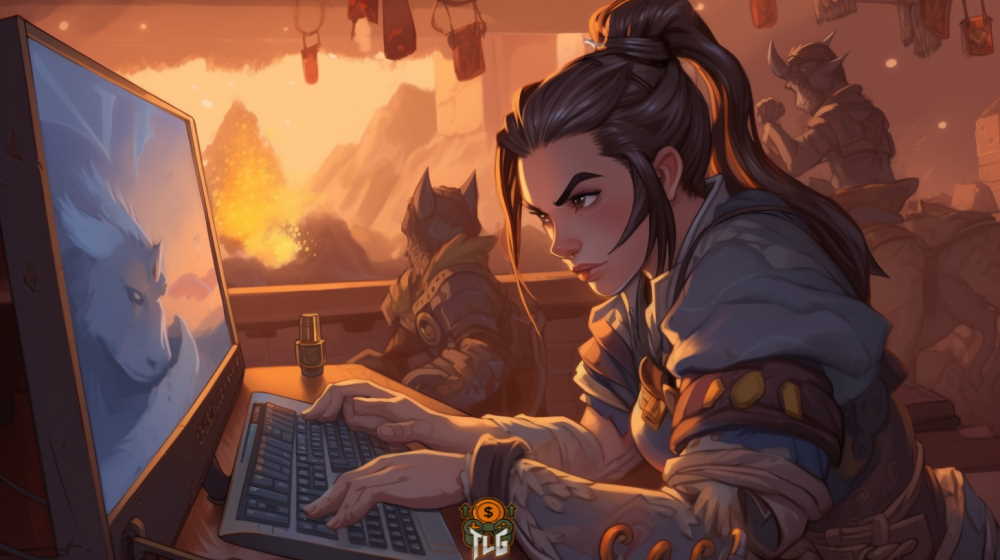Player versus environment (PvE) is a term used in the gaming world to describe the mode of gameplay where players fight computer-controlled enemies. It is a popular feature in both single player and online games, particularly in MMORPGs, CORPGs, MUDs, and other online role-playing video games.
In PvE, players are pitted against non-playable characters (NPCs) that are controlled by the game’s artificial intelligence. These NPCs can take various forms, such as monsters, animals, or robots, and are designed to pose a challenge to the player’s skills and abilities. PvE is often used as a means of advancing the game’s storyline, as players must defeat these enemies to progress to higher levels and unlock new areas.
PvE is often contrasted with Player versus Player (PvP) mode, where players compete against each other in combat. While PvP is more focused on testing a player’s skills against other human players, PvE is geared towards offering a more immersive and story-driven experience. The popularity of PvE has led to its inclusion in a wide range of games, from classic RPGs to modern first-person shooters.
What is PvE in Gaming?
Definition of PvE
PvE stands for Player versus Environment or Player versus Enemy. In this type of video game, players compete against the game’s artificial intelligence (AI), rather than other players. PvE games require players to fight computer-generated monsters or enemies, as opposed to fighting other human players (as required in player versus player or PvP games). PvE is usually typed as pve or PvE.
PvE vs PvP
PvE and PvP are two different types of gameplay in video games. PvP stands for Player versus Player, where players compete against each other directly. It’s a game mode that revolves around player-against-player combat.
On the other hand, PvE is a game mode where players fight against computer-controlled creatures or characters. The environment is the opponent, and players must overcome various challenges to progress through the game.
Examples of PvE Games
There are many examples of PvE games, including:
- World of Warcraft: This is a popular MMORPG that features PvE gameplay. Players must complete quests and fight monsters to progress through the game.
- Diablo III: This is an action role-playing game that features PvE gameplay. Players must explore dungeons and fight monsters to progress through the game.
- Minecraft: This is a sandbox game that features both PvE and PvP gameplay. Players can explore the game world, build structures, and fight monsters.
- The Elder Scrolls V: Skyrim: This is an open-world action role-playing game that features PvE gameplay. Players must complete quests and fight monsters to progress through the game.
In conclusion, PvE games are a popular type of video game where players compete against the game’s artificial intelligence. It’s a game mode where players fight against computer-controlled creatures or characters. PvE games are popular in many genres, including MMORPGs, action role-playing games, and sandbox games.
Why is PvE Important?
PvE, or Player versus Environment, is an essential aspect of gaming that allows players to engage in combat with computer-controlled enemies. PvE is a crucial element of game design that provides players with a challenging and immersive experience. This section will explore the role of PvE in game design, the benefits of PvE for players, and the challenges of PvE.
Role of PvE in Game Design
PvE plays a significant role in game design, as it allows developers to create a rich and immersive game world that players can explore. PvE provides players with a sense of progression as they defeat increasingly challenging enemies and progress through the game’s storyline. PvE also helps to develop a player’s skills and abilities, as they learn how to strategize and overcome obstacles.
Benefits of PvE for Players
PvE offers several benefits for players, including the opportunity to test their skills against challenging opponents without the pressure of competing against other players. PvE also allows players to explore and discover new worlds, characters, and storylines. Additionally, PvE can be a relaxing and enjoyable experience for players who want to unwind and escape from the stresses of real life.
Challenges of PvE
One of the challenges of PvE is balancing the difficulty of enemies to ensure that players are challenged but not frustrated. Developers must also ensure that the game’s mechanics are fair and consistent, so players do not feel cheated. Another challenge is creating a sense of progression and accomplishment for players, so they feel motivated to continue playing.
In conclusion, PvE is an important aspect of gaming that provides players with a challenging and immersive experience. PvE plays a significant role in game design, offers several benefits for players, and presents unique challenges for developers.
Types of PvE
PvE games come in different types, each with its unique features and gameplay. Here are some of the most common types of PvE games:
Questing and Storytelling PvE
In this type of PvE game, players embark on a journey to complete quests and progress through a storyline. The quests usually involve killing monsters, gathering items, or interacting with non-playable characters (NPCs). The storyline provides a sense of purpose and direction for the player, making the game more immersive and engaging.
Dungeon and Raid PvE
Dungeon and raid PvE games involve players teaming up to explore and conquer challenging dungeons and raids. Dungeons are smaller instances that can be completed by a group of 3-5 players, while raids are larger instances that require a team of 10-25 players to complete. These games often require players to coordinate their actions and use their skills and abilities effectively to defeat powerful bosses and earn rewards.
Open World PvE
Open world PvE games provide players with a vast, open world to explore and interact with. Players can engage in various activities, such as completing quests, fighting monsters, gathering resources, or interacting with other players. The game world usually contains different zones with varying levels of difficulty, providing a sense of progression and challenge for the player.
Survival PvE
Survival PvE games are all about surviving in a harsh and unforgiving environment. Players must gather resources, build shelters, and fend off hostile creatures to stay alive. These games often feature permadeath, meaning that if the player dies, they lose all their progress and must start over. Survival PvE games can be very challenging and require careful planning and strategy to succeed.
Overall, PvE games offer a variety of gameplay experiences for players who prefer to play against the environment rather than other players. Whether you enjoy questing, raiding, exploring, or surviving, there is a PvE game out there for you.
PvE Strategies and Tactics
Class and Role Selection
Choosing the right class and role is crucial in PvE gameplay. Players should consider the strengths and weaknesses of each class and role before making a decision. For example, a tank class is responsible for drawing enemy fire away from other players and absorbing damage, while a healer class is responsible for keeping the group alive by healing and removing debuffs. A damage dealer (DPS) class is responsible for dealing damage to enemies.
Group Dynamics
In PvE, teamwork is essential for success. Players should communicate effectively and work together to achieve their goals. It’s important to understand each player’s role and how they can contribute to the group’s success. A well-rounded group typically includes a tank, healer, and DPS. It’s also important to have backup plans in case a player disconnects or has to leave the game unexpectedly.
Combat Mechanics
Understanding the game’s combat mechanics is crucial in PvE gameplay. Players should know how to use their abilities effectively and efficiently. For example, a tank should know when to use their taunt ability to draw enemy fire away from other players. Healers should prioritize healing the tank and other players who are taking damage. DPS players should focus on dealing damage to enemies while avoiding taking damage themselves.
Players should also know how to manage their resources effectively. For example, a healer should conserve their mana by using efficient healing spells when possible. Tanks should manage their rage or energy levels to ensure they can use their abilities when needed.
In conclusion, PvE gameplay requires careful planning, effective communication, and a solid understanding of class and role mechanics. By following these strategies and tactics, players can achieve success and enjoy the game to its fullest.
Conclusion
In summary, Player versus Environment (PvE) is a popular game mode in which players cooperate or compete against computer-controlled enemies. This mode is commonly found in online role-playing video games and survival games. PvE is the opposite of Player versus Player (PvP), where players compete against each other.
PvE games provide a variety of challenges and rewards for players. They offer a storyline mode that allows players to experience the game’s narrative and complete quests. PvE games also feature different difficulty levels, allowing players to choose the level of challenge they want to face.
One of the benefits of PvE games is that they allow players to practice their skills before competing against other players in PvP mode. PvE games provide a safe environment for players to learn the game mechanics, explore the game world, and develop their characters.
PvE games also offer a more relaxed and social gaming experience. Players can team up with other players to complete quests and defeat enemies. PvE games encourage cooperation and teamwork, which can lead to lasting friendships.
Overall, PvE games are an excellent choice for players who enjoy a more relaxed and cooperative gaming experience. PvE games provide a safe environment for players to learn the game mechanics, explore the game world, and develop their characters. They also offer a variety of challenges and rewards, making them a popular choice among gamers.


